engine SATURN ASTRA 2008 Owner's Guide
[x] Cancel search | Manufacturer: SATURN, Model Year: 2008, Model line: ASTRA, Model: SATURN ASTRA 2008Pages: 304, PDF Size: 1.92 MB
Page 178 of 304
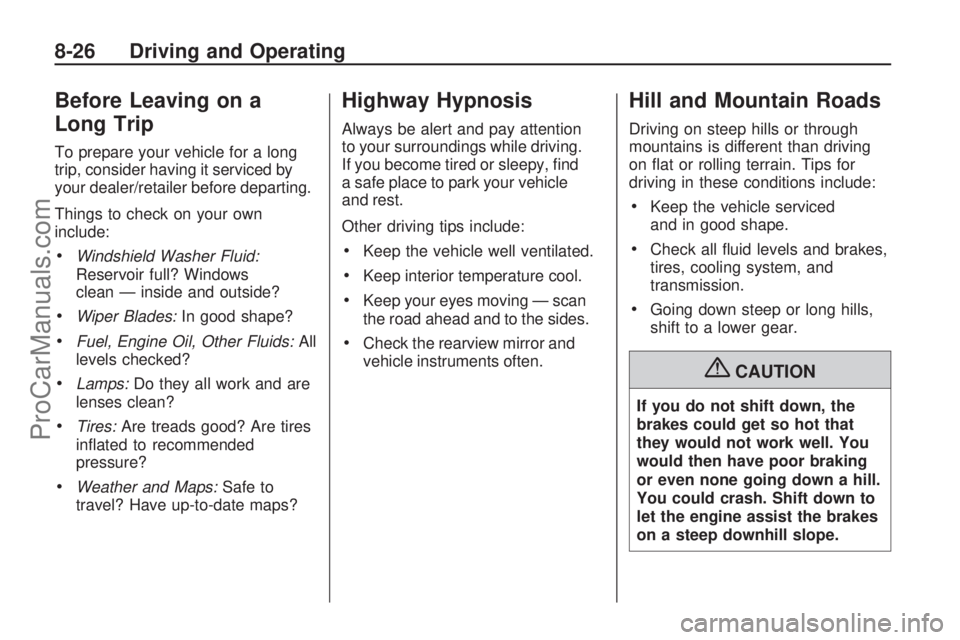
Before Leaving on a
Long Trip
To prepare your vehicle for a long
trip, consider having it serviced by
your dealer/retailer before departing.
Things to check on your own
include:
Windshield Washer Fluid:
Reservoir full? Windows
clean — inside and outside?
Wiper Blades:In good shape?
Fuel, Engine Oil, Other Fluids:All
levels checked?
Lamps:Do they all work and are
lenses clean?
Tires:Are treads good? Are tires
in�ated to recommended
pressure?
Weather and Maps:Safe to
travel? Have up-to-date maps?
Highway Hypnosis
Always be alert and pay attention
to your surroundings while driving.
If you become tired or sleepy, �nd
a safe place to park your vehicle
and rest.
Other driving tips include:
Keep the vehicle well ventilated.
Keep interior temperature cool.
Keep your eyes moving — scan
the road ahead and to the sides.
Check the rearview mirror and
vehicle instruments often.
Hill and Mountain Roads
Driving on steep hills or through
mountains is different than driving
on �at or rolling terrain. Tips for
driving in these conditions include:
Keep the vehicle serviced
and in good shape.
Check all �uid levels and brakes,
tires, cooling system, and
transmission.
Going down steep or long hills,
shift to a lower gear.
{CAUTION
If you do not shift down, the
brakes could get so hot that
they would not work well. You
would then have poor braking
or even none going down a hill.
You could crash. Shift down to
let the engine assist the brakes
on a steep downhill slope.
8-26 Driving and Operating
ProCarManuals.com
Page 179 of 304

{CAUTION
Coasting downhill in N (Neutral)
or with the ignition off is
dangerous. The brakes will
have to do all the work of
slowing down and they could
get so hot that they would not
work well. You would then have
poor braking or even none
going down a hill. You could
crash. Always have the engine
running and the vehicle in gear
when going downhill.
Stay in your own lane. Do not
swing wide or cut across the
center of the road. Drive at
speeds that let you stay in your
own lane.
Top of hills: Be alert — something
could be in your lane (stalled car,
accident).
Pay attention to special road
signs (falling rocks area, winding
roads, long grades, passing or
no-passing zones) and take
appropriate action.
Winter Driving
Here are some tips for winter
driving:
Have your vehicle in good shape
for winter.
You might want to put winter
emergency supplies in your
vehicle.
Include an ice scraper, a small
brush or broom, a supply of
windshield washer �uid, a rag, some
winter outer clothing, a small shovel,
a �ashlight, a red cloth, and re�ective
warning triangles. And, if you will be
driving under severe conditions,
include a small bag of sand, a pieceof old carpet, or a couple of burlap
bags to help provide traction. Be sure
you properly secure these items in
your vehicle.
Also seeTires on page 9-38.
Driving on Snow or Ice
Most of the time, those places
where the tires meet the road
probably have good traction.
However, if there is snow or ice
between the tires and the road, you
can have a very slippery situation.
You have a lot less traction, or grip,
and need to be very careful.
What is the worst time for this? Wet
ice. Very cold snow or ice can be
slick and hard to drive on. But wet ice
can be even more trouble because it
can offer the least traction of all.
Driving and Operating 8-27
ProCarManuals.com
Page 180 of 304

You can get wet ice when it is about
freezing, 32°F (0°C), and freezing
rain begins to fall. Try to avoid driving
on wet ice until salt and sand crews
can get there.
Whatever the condition — smooth
ice, packed, blowing, or loose
snow — drive with caution.
Accelerate gently. Try not to
break the fragile traction. If you
accelerate too fast, the drive wheels
will spin and polish the surface
under the tires even more.
The Antilock Brake System (ABS)
improves your vehicle’s stability
when you make a hard stop
on a slippery road. Even though you
have ABS, begin stopping soonerthan you would on dry pavement.
SeeAntilock Brake System
(ABS) on page 8-18.
Allow greater following distance
on any slippery road.
Watch for slippery spots. The
road might be �ne until you hit
a spot that is covered with ice.
On an otherwise clear road, ice
patches can appear in shaded
areas where the sun cannot
reach, such as around clumps of
trees, behind buildings, or under
bridges. Sometimes the surface
of a curve or an overpass can
remain icy when the surrounding
roads are clear. If you see a patch
of ice ahead of you, brake before
you are on it. Try not to brake
while you are actually on the ice,
and avoid sudden steering
maneuvers.
If You Are Caught in a Blizzard
If you are stopped by heavy
snow, you could be in a serious
situation. You should probably
stay with your vehicle unless you
know for sure that you are near
help and you can hike through the
snow. Here are some things to do
to summon help and keep yourself
and your passengers safe:
Turn on the hazard warning
�ashers.
Tie a red cloth to your vehicle to
alert police that you have been
stopped by the snow.
Put on extra clothing or wrap a
blanket around you. If you do not
have blankets or extra clothing,
make body insulators from
newspapers, burlap bags, rags,
�oor mats — anything you can
wrap around yourself or tuck
under your clothing to keep warm.
You can run the engine to keep
warm, but be careful.
8-28 Driving and Operating
ProCarManuals.com
Page 181 of 304
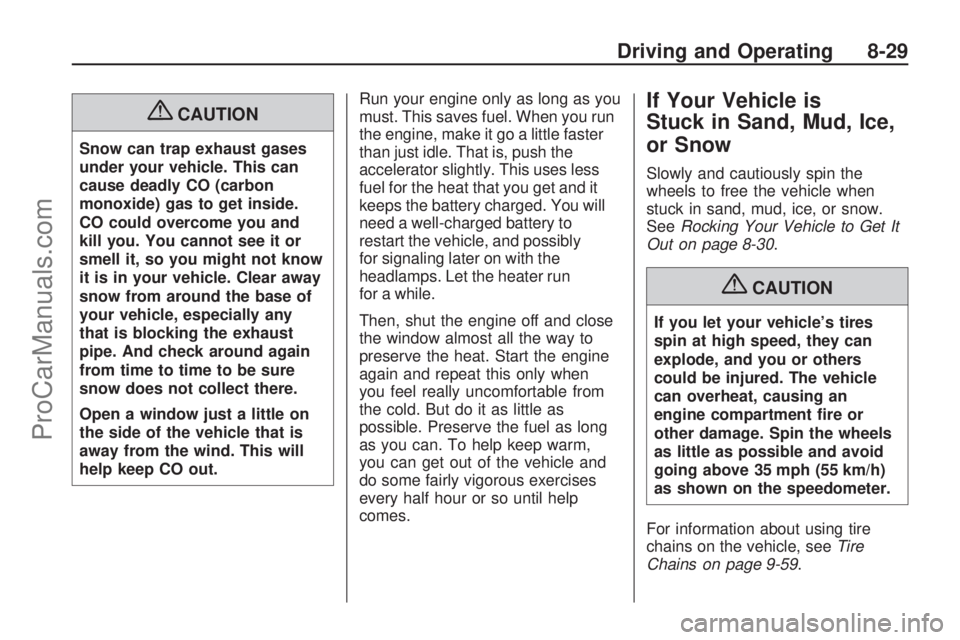
{CAUTION
Snow can trap exhaust gases
under your vehicle. This can
cause deadly CO (carbon
monoxide) gas to get inside.
CO could overcome you and
kill you. You cannot see it or
smell it, so you might not know
it is in your vehicle. Clear away
snow from around the base of
your vehicle, especially any
that is blocking the exhaust
pipe. And check around again
from time to time to be sure
snow does not collect there.
Open a window just a little on
the side of the vehicle that is
away from the wind. This will
help keep CO out.Run your engine only as long as you
must. This saves fuel. When you run
the engine, make it go a little faster
than just idle. That is, push the
accelerator slightly. This uses less
fuel for the heat that you get and it
keeps the battery charged. You will
need a well-charged battery to
restart the vehicle, and possibly
for signaling later on with the
headlamps. Let the heater run
for a while.
Then, shut the engine off and close
the window almost all the way to
preserve the heat. Start the engine
again and repeat this only when
you feel really uncomfortable from
the cold. But do it as little as
possible. Preserve the fuel as long
as you can. To help keep warm,
you can get out of the vehicle and
do some fairly vigorous exercises
every half hour or so until help
comes.
If Your Vehicle is
Stuck in Sand, Mud, Ice,
or Snow
Slowly and cautiously spin the
wheels to free the vehicle when
stuck in sand, mud, ice, or snow.
SeeRocking Your Vehicle to Get It
Out on page 8-30.
{CAUTION
If you let your vehicle’s tires
spin at high speed, they can
explode, and you or others
could be injured. The vehicle
can overheat, causing an
engine compartment �re or
other damage. Spin the wheels
as little as possible and avoid
going above 35 mph (55 km/h)
as shown on the speedometer.
For information about using tire
chains on the vehicle, seeTire
Chains on page 9-59.
Driving and Operating 8-29
ProCarManuals.com
Page 187 of 304
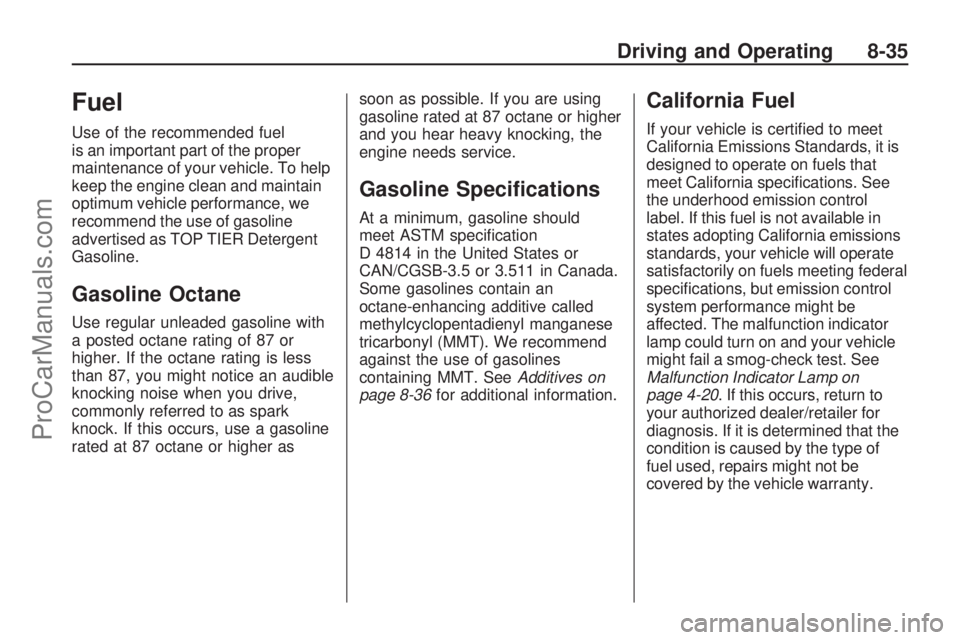
Fuel
Use of the recommended fuel
is an important part of the proper
maintenance of your vehicle. To help
keep the engine clean and maintain
optimum vehicle performance, we
recommend the use of gasoline
advertised as TOP TIER Detergent
Gasoline.
Gasoline Octane
Use regular unleaded gasoline with
a posted octane rating of 87 or
higher. If the octane rating is less
than 87, you might notice an audible
knocking noise when you drive,
commonly referred to as spark
knock. If this occurs, use a gasoline
rated at 87 octane or higher assoon as possible. If you are using
gasoline rated at 87 octane or higher
and you hear heavy knocking, the
engine needs service.
Gasoline Speci�cations
At a minimum, gasoline should
meet ASTM speci�cation
D 4814 in the United States or
CAN/CGSB-3.5 or 3.511 in Canada.
Some gasolines contain an
octane-enhancing additive called
methylcyclopentadienyl manganese
tricarbonyl (MMT). We recommend
against the use of gasolines
containing MMT. SeeAdditives on
page 8-36for additional information.
California Fuel
If your vehicle is certi�ed to meet
California Emissions Standards, it is
designed to operate on fuels that
meet California speci�cations. See
the underhood emission control
label. If this fuel is not available in
states adopting California emissions
standards, your vehicle will operate
satisfactorily on fuels meeting federal
speci�cations, but emission control
system performance might be
affected. The malfunction indicator
lamp could turn on and your vehicle
might fail a smog-check test. See
Malfunction Indicator Lamp on
page 4-20. If this occurs, return to
your authorized dealer/retailer for
diagnosis. If it is determined that the
condition is caused by the type of
fuel used, repairs might not be
covered by the vehicle warranty.
Driving and Operating 8-35
ProCarManuals.com
Page 188 of 304
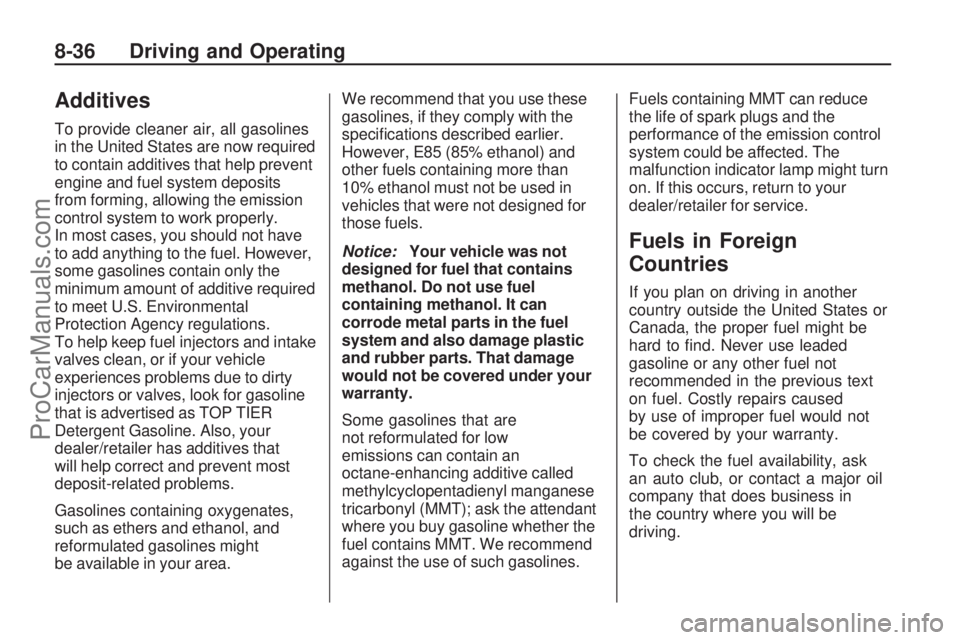
Additives
To provide cleaner air, all gasolines
in the United States are now required
to contain additives that help prevent
engine and fuel system deposits
from forming, allowing the emission
control system to work properly.
In most cases, you should not have
to add anything to the fuel. However,
some gasolines contain only the
minimum amount of additive required
to meet U.S. Environmental
Protection Agency regulations.
To help keep fuel injectors and intake
valves clean, or if your vehicle
experiences problems due to dirty
injectors or valves, look for gasoline
that is advertised as TOP TIER
Detergent Gasoline. Also, your
dealer/retailer has additives that
will help correct and prevent most
deposit-related problems.
Gasolines containing oxygenates,
such as ethers and ethanol, and
reformulated gasolines might
be available in your area.We recommend that you use these
gasolines, if they comply with the
speci�cations described earlier.
However, E85 (85% ethanol) and
other fuels containing more than
10% ethanol must not be used in
vehicles that were not designed for
those fuels.
Notice:Your vehicle was not
designed for fuel that contains
methanol. Do not use fuel
containing methanol. It can
corrode metal parts in the fuel
system and also damage plastic
and rubber parts. That damage
would not be covered under your
warranty.
Some gasolines that are
not reformulated for low
emissions can contain an
octane-enhancing additive called
methylcyclopentadienyl manganese
tricarbonyl (MMT); ask the attendant
where you buy gasoline whether the
fuel contains MMT. We recommend
against the use of such gasolines.Fuels containing MMT can reduce
the life of spark plugs and the
performance of the emission control
system could be affected. The
malfunction indicator lamp might turn
on. If this occurs, return to your
dealer/retailer for service.
Fuels in Foreign
Countries
If you plan on driving in another
country outside the United States or
Canada, the proper fuel might be
hard to �nd. Never use leaded
gasoline or any other fuel not
recommended in the previous text
on fuel. Costly repairs caused
by use of improper fuel would not
be covered by your warranty.
To check the fuel availability, ask
an auto club, or contact a major oil
company that does business in
the country where you will be
driving.
8-36 Driving and Operating
ProCarManuals.com
Page 189 of 304
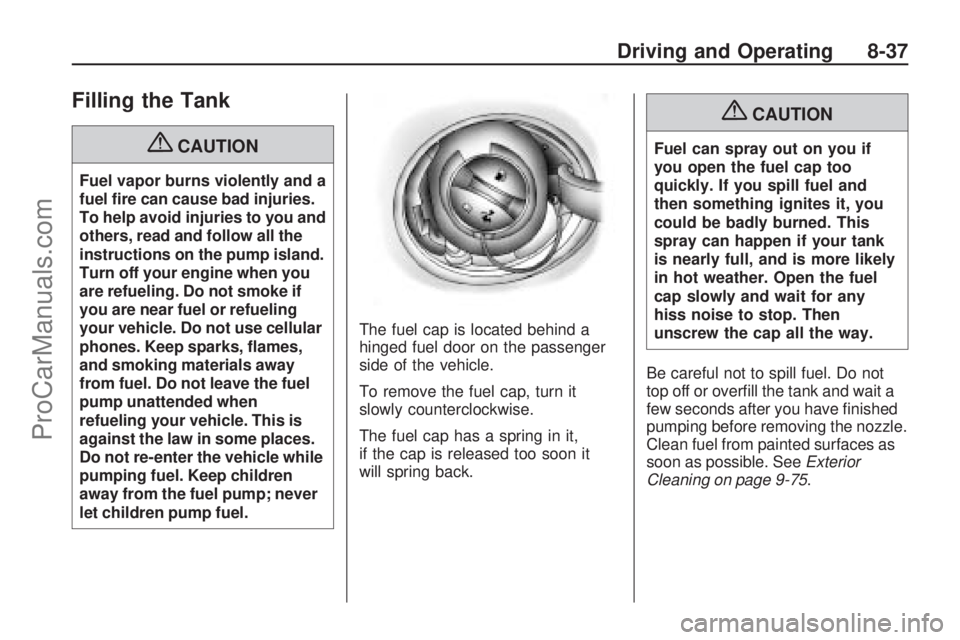
Filling the Tank
{CAUTION
Fuel vapor burns violently and a
fuel �re can cause bad injuries.
To help avoid injuries to you and
others, read and follow all the
instructions on the pump island.
Turn off your engine when you
are refueling. Do not smoke if
you are near fuel or refueling
your vehicle. Do not use cellular
phones. Keep sparks, �ames,
and smoking materials away
from fuel. Do not leave the fuel
pump unattended when
refueling your vehicle. This is
against the law in some places.
Do not re-enter the vehicle while
pumping fuel. Keep children
away from the fuel pump; never
let children pump fuel.The fuel cap is located behind a
hinged fuel door on the passenger
side of the vehicle.
To remove the fuel cap, turn it
slowly counterclockwise.
The fuel cap has a spring in it,
if the cap is released too soon it
will spring back.
{CAUTION
Fuel can spray out on you if
you open the fuel cap too
quickly. If you spill fuel and
then something ignites it, you
could be badly burned. This
spray can happen if your tank
is nearly full, and is more likely
in hot weather. Open the fuel
cap slowly and wait for any
hiss noise to stop. Then
unscrew the cap all the way.
Be careful not to spill fuel. Do not
top off or over�ll the tank and wait a
few seconds after you have �nished
pumping before removing the nozzle.
Clean fuel from painted surfaces as
soon as possible. SeeExterior
Cleaning on page 9-75.
Driving and Operating 8-37
ProCarManuals.com
Page 191 of 304
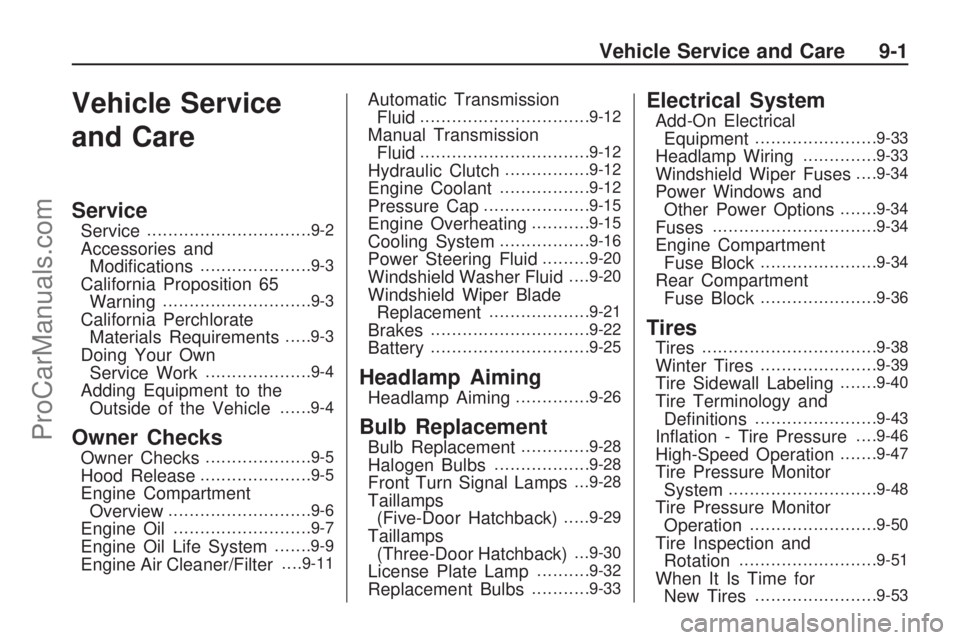
Vehicle Service
and Care
Service
Service...............................9-2
Accessories and
Modi�cations.....................9-3
California Proposition 65
Warning............................9-3
California Perchlorate
Materials Requirements.....9-3
Doing Your Own
Service Work....................9-4
Adding Equipment to the
Outside of the Vehicle......9-4
Owner Checks
Owner Checks....................9-5
Hood Release.....................9-5
Engine Compartment
Overview...........................9-6
Engine Oil..........................9-7
Engine Oil Life System.......9-9
Engine Air Cleaner/Filter. . . .9-11
Automatic Transmission
Fluid................................9-12
Manual Transmission
Fluid................................9-12
Hydraulic Clutch................9-12
Engine Coolant.................9-12
Pressure Cap....................9-15
Engine Overheating...........9-15
Cooling System.................9-16
Power Steering Fluid.........9-20
Windshield Washer Fluid. . . .9-20
Windshield Wiper Blade
Replacement...................9-21
Brakes..............................9-22
Battery..............................9-25
Headlamp Aiming
Headlamp Aiming..............9-26
Bulb Replacement
Bulb Replacement.............9-28
Halogen Bulbs..................9-28
Front Turn Signal Lamps. . .9-28
Taillamps
(Five-Door Hatchback).....9-29
Taillamps
(Three-Door Hatchback). . .9-30
License Plate Lamp..........9-32
Replacement Bulbs...........9-33
Electrical System
Add-On Electrical
Equipment.......................9-33
Headlamp Wiring..............9-33
Windshield Wiper Fuses. . . .9-34
Power Windows and
Other Power Options.......9-34
Fuses...............................9-34
Engine Compartment
Fuse Block......................9-34
Rear Compartment
Fuse Block......................9-36
Tires
Tires.................................9-38
Winter Tires......................9-39
Tire Sidewall Labeling.......9-40
Tire Terminology and
De�nitions.......................9-43
In�ation - Tire Pressure. . . .9-46
High-Speed Operation.......9-47
Tire Pressure Monitor
System............................9-48
Tire Pressure Monitor
Operation........................9-50
Tire Inspection and
Rotation..........................9-51
When It Is Time for
New Tires.......................9-53
Vehicle Service and Care 9-1
ProCarManuals.com
Page 193 of 304

Accessories and
Modi�cations
When non-dealer/non-retailer
accessories are added to your
vehicle they can affect your vehicle’s
performance and safety, including
such things as, airbags, braking,
stability, ride and handling,
emissions systems, aerodynamics,
durability, and electronic systems like
antilock brakes, traction control and
stability control. Some of these
accessories could even cause
malfunction or damage not covered
by warranty.
GM Accessories are designed to
complement and function with other
systems on your vehicle. Your GM
dealer/retailer can accessorize
your vehicle using genuine GM
Accessories. When you go to your
GM dealer/retailer and ask forGM Accessories, you will know that
GM-trained and supported service
technicians will perform the work
using genuine GM Accessories.
Also, seeAdding Equipment to
Your Airbag-Equipped Vehicle on
page 1-35.
California Proposition 65
Warning
Most motor vehicles, including this
one, contain and/or emit chemicals
known to the State of California
to cause cancer and birth defects or
other reproductive harm. Engine
exhaust, many parts and systems
(including some inside the vehicle),
many �uids, and some component
wear by-products contain and/or
emit these chemicals.
California Perchlorate
Materials Requirements
Certain types of automotive
applications, such as airbag
initiators, seat belt pretensioners,
and lithium batteries contained
in remote keyless entry transmitters,
may contain perchlorate materials.
Special handling may be necessary.
For additional information, see
www.dtsc.ca.gov/hazardouswaste/
perchlorate.
Vehicle Service and Care 9-3
ProCarManuals.com
Page 195 of 304
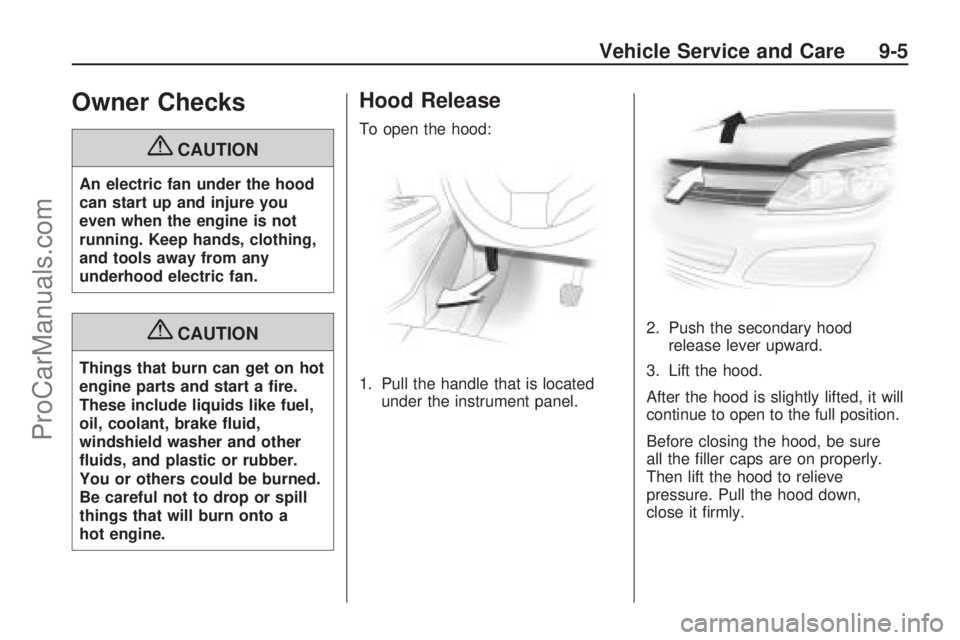
Owner Checks
{CAUTION
An electric fan under the hood
can start up and injure you
even when the engine is not
running. Keep hands, clothing,
and tools away from any
underhood electric fan.
{CAUTION
Things that burn can get on hot
engine parts and start a �re.
These include liquids like fuel,
oil, coolant, brake �uid,
windshield washer and other
�uids, and plastic or rubber.
You or others could be burned.
Be careful not to drop or spill
things that will burn onto a
hot engine.
Hood Release
To open the hood:
1. Pull the handle that is located
under the instrument panel.2. Push the secondary hood
release lever upward.
3. Lift the hood.
After the hood is slightly lifted, it will
continue to open to the full position.
Before closing the hood, be sure
all the �ller caps are on properly.
Then lift the hood to relieve
pressure. Pull the hood down,
close it �rmly.
Vehicle Service and Care 9-5
ProCarManuals.com